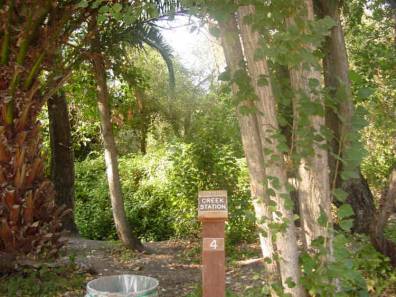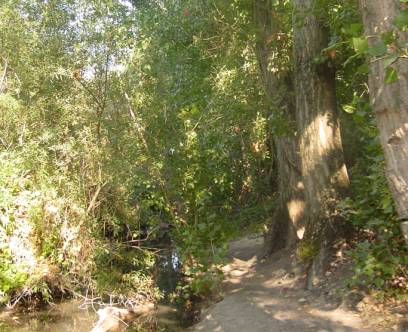STATION 4.
CREEK STUDY

A large palm tree shades this area
for creek study along Muskrat Creek. Usually
the water is slowing moving downstream and you can sometimes see small fish in
the larger pools. Creeks in Fremont
had larger flows in the past. Large
underground aquifers feed many of the streams throughout the year.
In areas where faults are located, the water steeps upward forming marsh
lands. However, as Fremont became urbanized different agencies started to
control the flow of water, in part to control flooding and
maintain the aquifers. Muskrat
Creek is in part water from Mission Creek and overflow of water flowing from
Hetch Hetchy pipelines that supply water to San Francisco and other cities along
its route.
 Muskrat
Creek has a canopy of cottonwoods, and willows. All of the trees are native to a Fremont riparian zone except
the palm tree, whose seed was probably brought to the area by a bird over 25
years ago.
Muskrat
Creek has a canopy of cottonwoods, and willows. All of the trees are native to a Fremont riparian zone except
the palm tree, whose seed was probably brought to the area by a bird over 25
years ago.
Within the aquatic
zone, biological life helps us
determine the health of the stream. This
is referred to as biological assessment. By observing the types
of small invertebrates with respect to diversity and number, you can access
whether the stream is healthy or not.
LESSON. Measuring Streamflow
- Streamflow is important because a
steady flow helps to keep an area
aerated. Velocity is a measurement
of how fast something moves. Water
can be measured by timing how fast a floating object travels 50 feet in a
stream. Select an object that
floats low in the water, pin pong ball, fishing bobber, or small branch.
LESSON. Determining
the direction of stream flow.
- Explain how to use a
compass with students. The needle always points to North, and then you adjust the
compass itself to indicate that is North. After
you orientate the compass, ask students to find the direction of the flow.
The flow is almost west to northwest.
LESSON. Water Quality -Measuring
temperature, nitrate, oxygen, and pH can help you determine the chemical fitness
of the water for living organisms. These
activities need more preparation, as you will need equipment.
Temperature can be measured with a thermometer.
However pH, oxygen and nitrate require a chemical kit.
We recommend LaMotte kits. You
can also use pH paper to help determine the pH, without a kit.
LESSON. Bioassessment -The type of organisms in a creek reflects
the quality of the water. We
recommend using the California Bioassessment protocol that is provided in the
appendix.
[BACK]

